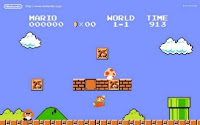Computer Game Graphics
Pixel
Art
 A form of
design in game where an image is built up and edited through the use of many
pixel with them being the smallest building block within design, often taking
the form of a 2D sprite or 3D isometric sprites. Often found in older games or
in those created by indie developers some famous examples of these are Mario,
2D Zelda games, Castlevania, and Super Meat boy.
A form of
design in game where an image is built up and edited through the use of many
pixel with them being the smallest building block within design, often taking
the form of a 2D sprite or 3D isometric sprites. Often found in older games or
in those created by indie developers some famous examples of these are Mario,
2D Zelda games, Castlevania, and Super Meat boy.
Concept
Art
Used to
showcase an idea or design, concept art can be used to present the look of
things such as an ingame item, weapons, vehicles, characters, environments and
many more such as these used in the creation of Metal Gear Solid V: The Phantom
Pain. This
concept art shows the lead protagonist and player charcter, Big Boss, and
clearly shows is details of the characters over all appearance such as his
clothes, hair, facial feature, robot arm and makes clear where an unseen
insignia would be placed.
Texture Art
Texture art is used in finalising the appearance of something
with it often being applied to things in the landscape in order to help add to
the atmosphere within a game, a clear example of this is within the silent hill
series where the player enters the distorted world and is a hellish environment
designed to evoke a sense of dread within the player. Another use is a games
skybox which is present in many many 3D games, aiding in giving the enviorment
a 3D look and feel. Texture art has always been a key part of game design with
an obvious example being the brick texture in the original Super Mario Game
Background Graphics
 Like
my earlier example of graphics, objects that build up the location’s scenery
like lakes, mountains, any type of buildings (e.g. a castle) and trees are made
to become part of a background creating depth within the world. Levels that use
things like snow to create atmosphere add things like rain par5ticles giving
the world around the player a more alive feeling immersing the player even
Like
my earlier example of graphics, objects that build up the location’s scenery
like lakes, mountains, any type of buildings (e.g. a castle) and trees are made
to become part of a background creating depth within the world. Levels that use
things like snow to create atmosphere add things like rain par5ticles giving
the world around the player a more alive feeling immersing the player even
In Game Interface
 An ingame interface is either an or a set of icons giving the
player information about what is happening within the game, often called a
Heads Up Display (or HUD for short) it shows the player charcter vital
information such as their health bars, objective, any sort of time linit there
may be or any other bars and status ailments. Some games such as Dead Space
intergrate the heads up display into the character themselves to add an extra
layer of immersion with the ammo counter being holographically didplayed by the
gun and the health bar being displayed on the suit.
An ingame interface is either an or a set of icons giving the
player information about what is happening within the game, often called a
Heads Up Display (or HUD for short) it shows the player charcter vital
information such as their health bars, objective, any sort of time linit there
may be or any other bars and status ailments. Some games such as Dead Space
intergrate the heads up display into the character themselves to add an extra
layer of immersion with the ammo counter being holographically didplayed by the
gun and the health bar being displayed on the suit.
Print Media
Print media needs to catch the eye but be faithful to the title it advertises as to not give the wrong impression of the game such as confusing the genre of the title by showing a 3D game and actually being a 2D platformer. The box art will often prodominantly feature the main protagoinist showing any potential buyer the character they’ll be in control of and a more generic blank charcter with no real identity if it’s a multiplayer focused game showing its not about a certain character and their storyline.






No comments:
Post a Comment